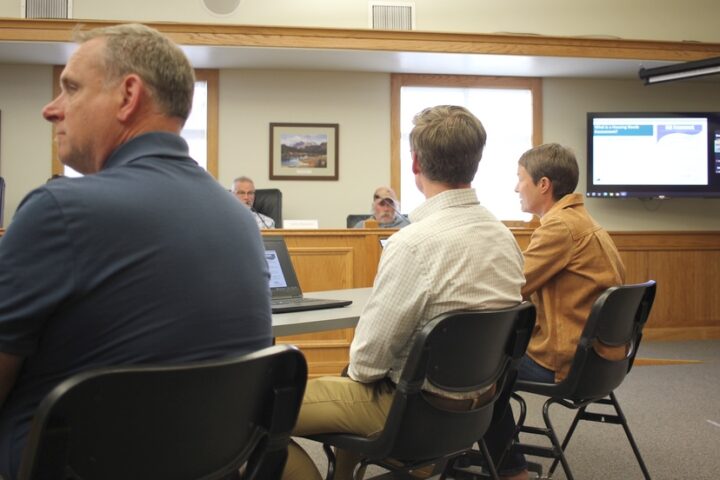I feel like we parents are always under so much pressure to create this perfect Instagram or Pinterest-worthy house. Like, we’re somehow failing at life if we don’t have a book nook, a homework zone, an imagination station, a farmhouse kitchen with a walk-in pantry, or whatever other fancy room idea is trending this week on social media…
— Ursula Herrera, writing for CreativeHealthyFamily.com
I don’t use social media, so I have no idea what might be trending on Instagram this week. I imagine some of the postings include photos of people’s houses, as they do their best to make their houses into ‘homes’.
A house is not necessarily a home, as Ms. Herrera suggests.
Workers in Archuleta County who are currently without a home, however, would probably settle for a house. Ideally, one that won’t break the bank with inflated monthly payments.
A joint meeting last week, involving the Pagosa Springs Town Council and the Archuleta Board of County Commissioners, spent some time discussing houses — not homes, but houses — and in that regard, a newly published ‘Housing Needs Assessment’ produced on behalf of the Town and County by ECONorthwest and Western Spaces. The consultant from Western Spaces, Sarah McClain, was on hand to field questions about the 112-page report.
You can download the report here.

A ‘Housing Needs Assessment’ is a comprehensive study designed to evaluate the types and availability of housing within a community. It identifies existing housing conditions, affordability challenges, and potential gaps to help plan for future housing needs and prioritize strategies.
The new Town-County assessment that been produced by ECONorthwest and Western Spaces for a couple of good reasons. For one, Pagosa Springs is experiencing a serious housing crisis, but our elected leaders have had only a limited amount of ‘hard data’ to help them better understand the situation.
And for the other, the Colorado legislature passed a law last year, SB24-174, requiring municipalities in Colorado with more than 1,000 residents — that are not experiencing negative population growth — to conduct and publish a local Housing Needs Assessment by December 31, 2026, and at least every 6 years thereafter.
These assessments are typically used to guide housing policy and inform Housing Action Plans, which outline a strategy for a municipality to address housing challenges, such as affordability, availability, and diversity of housing options.
The report had been delivered to the Town and to the County a few days earlier, with the apparent expectation that both governments would officially adopt the study at their regular meetings the following day, April 15.
Here is an excerpt from the Executive Summary:
The assessment draws on extensive federal, state, and local data, including input from over 600 residents and nearly 100 employers. Their message is consistent: the shortage of affordable housing is hurting families and holding back the local economy.
- Sixty percent of businesses said housing shortages make it harder to attract and keep employees.
- Over 80% of businesses identify housing availability as a major or severe issue in the county.
- About 86% of households view housing availability as a major or severe issue in the county.
- Over half of renter households in Archuleta County spend more than 30% of their income on housing, classifying them as housing ‘cost burdened’,,, while 15% of county renter households spend more than 50% of their income on housing, classifying them as ‘severely cost burdened.’
- Rental availability is critically low, with a vacancy rate of just 0.5%, far below the healthy standard of 5%.
We knew about this problem 20 years ago, when the Town and County hired a different consulting firm — Economic and Planning Systems — to produce a Housing Needs Study. The report was duly delivered, but the Town and County did nothing of significance with the information.
Economic and Planning Systems produced another housing report in 2017, but once again, the Town and County did very little to address the problem.
The Town began to make some notable changes to its regulations after adopting the ‘Roadmap to Affordable Housing’ created by Pagosa Housing Partners in 2019. That report was backed by a survey of local workers, which indicated that housing stress was highest among the lowest-paid workers. Some regulatory changes at the Town, and the donation of vacant public land by the County resulted in the construction of 34 affordable housing units at Rose Mountain, across the street from Town Hall on Hot Springs Boulevard. That project was spearheaded by the Archuleta County Housing Authority.
Pagosa Housing Partners provided another set of survey results in 2021, with no obvious effect on our local elected officials.
The Town got another report in 2022 from Root Policy Research, which led to a slight increase in municipal Short-Term Rental (STR) fees… but the problem nevertheless got worse.
All during this time, the Town and County were investing millions of dollars into recreation and tourism, apparently believing that — while recreation and tourism required massive government subsidies — the housing crisis was to solve itself as the result of a few tweaks to land use regulations, plus the donation of a few parcels of publicly-owned residential property.
By encouraging economic growth in the recreation and tourism industries, our local governments were (unintentionally) fostering low-wage jobs in a community where housing costs were becoming oppressive.
Now we have the latest report.
Quote:
These numbers tell a story that many residents already know firsthand. Service workers are having to commute farther away to afford housing. Families are priced out of the market. Employers are scaling back hours or leaving jobs unfilled.
In response, the Town and County are not standing still. Both have made significant strides to encourage housing development:
- Pagosa Springs has adopted density bonuses, short-term rental limits, and land use reforms to allow smaller units and “missing middle” housing. It has also created a housing trust fund and secured state grants for infrastructure in workforce housing developments.
- Archuleta County has supported affordable housing through land donations, fee waivers, and tax incentives for deed-restricted housing. It also allows employer-provided housing at higher densities and has eased development regulations to unlock new housing options.
But local policies alone won’t close the gap. The analysis shows that Archuleta County as a region (unincorporated Archuleta County and Town of Pagosa Springs) needs at least 1,316 new housing units by 2035 to meet current shortages and support future workforce growth. This translates to an average of 132 housing units needed annually in the next 10 years.
1,316 new housing units?
Or do we actually need 1,316 new homes?
Because a house is not always a home.
Pagosa Springs has been building around 90 new homes per year, but — according to Region 9 Economic Development District — half of these new homes are ‘second homes’… or housing for retirees moving into the community… or are intended as vacation rentals.
Our construction industry, doing what it does best, may have been making the problem worse by creating housing for ‘non-workers’ who nevertheless require a functioning local economy.

